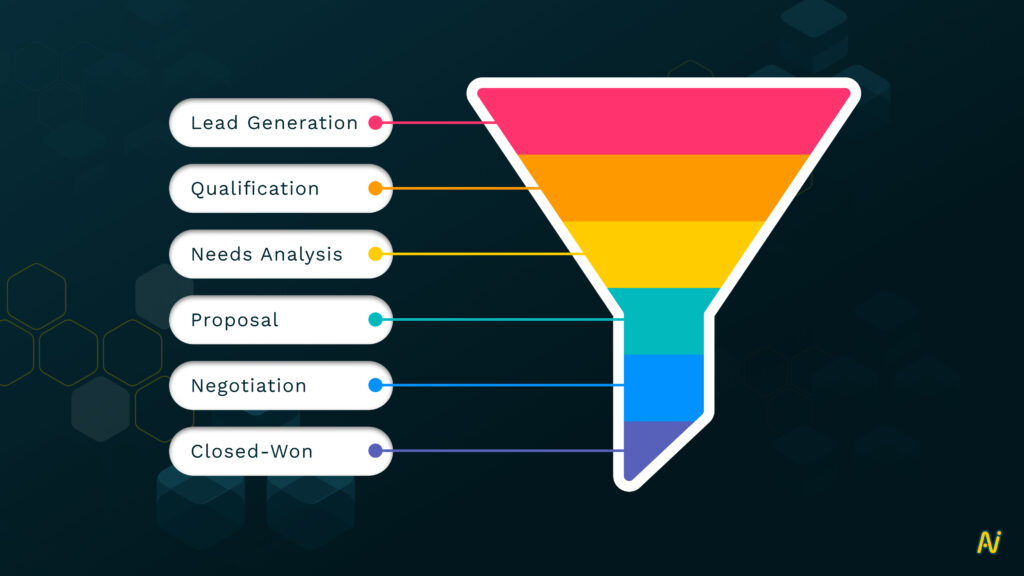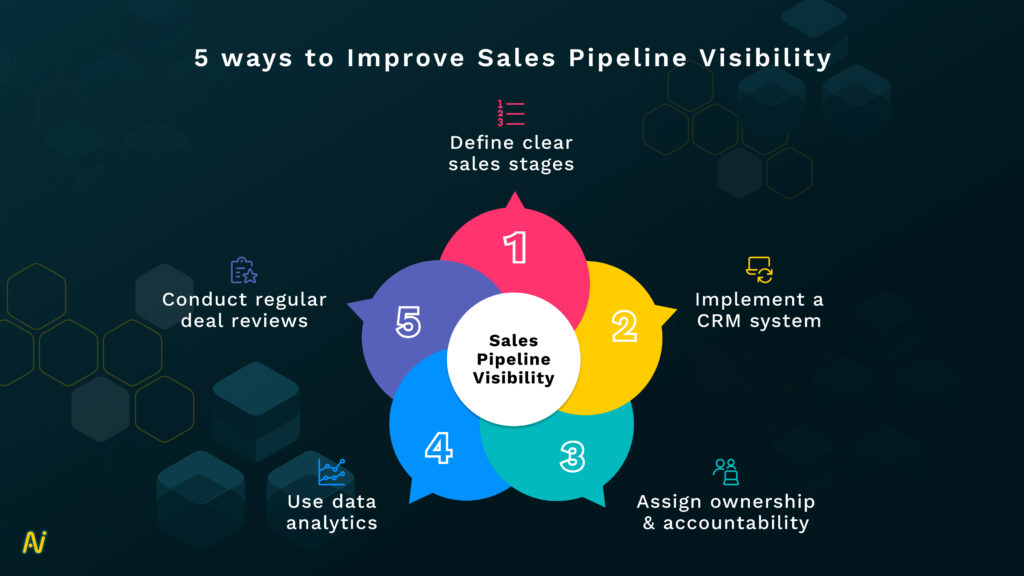Driving the sales pipeline in an organization is like driving a vehicle. You have a goal, a rough map of how to reach your destination, and you want to avoid roadblocks and reach the end-point quickly.
However, navigating a sales pipeline without proper visibility is like driving a car through the night without headlights. You might have a general idea of where you’re going, but you need help seeing the obstacles or opportunities ahead.
Just as headlights illuminate the road and allow you to make informed decisions about your driving, sales pipeline visibility provides insight into the status of your sales opportunities. It enables you to make strategic decisions to move deals forward.
93% of sales organizations are unable to forecast revenue within 5% error, even in the two weeks prior to the end of the quarter. A lack of visibility can result in overestimating the company’s financial performance, leading to missed targets, misaligned resources, and poor decision-making.
Without clear visibility into the pipeline, sales teams may not be able to prioritize leads effectively, resulting in missed opportunities and lost revenue. Poor visibility can also make it difficult to identify and address inefficiencies in the sales process, leading to longer sales cycles and decreased customer satisfaction.
In this blog, we try to understand what sales pipeline visibility is, the ways to improve it, and the role of clean data in your sales pipeline visibility.
What is Sales Pipeline Visibility?
Sales pipeline visibility refers to seeing and understanding the various stages of a company’s sales process, from lead generation to closing deals. Information in the form of data should be available to all revenue teams, including sales, marketing, finance, product management, and customer success.
The visibility in the sales pipeline allows sales managers and team members to track the progress of sales opportunities, identify potential bottlenecks or issues, and make informed decisions about resource allocation and sales strategy.
Typically, a sales pipeline comprises several stages: lead generation, qualification, needs analysis, proposal, negotiation, and closed-won.
Stages of a Sales Pipeline: Lead Generation, Qualification, Needs Analysis, Proposal, Negotiation, Closed-Won.

1. Lead generation
It’s the first stage of the sales pipeline, and it involves identifying potential customers. This can be done through various means, such as cold-calling, email campaigns, or social media outreach.
2. Qualification
Once leads are generated, they need to be qualified to ensure that they are a good fit for the product or service being sold. This process involves gathering more information about the lead, such as their budget, timeline, and decision-making process, to determine whether they are likely to make a purchase.
3. Needs analysis
In this stage, the sales team works with the potential customer to understand their specific needs and challenges, and how the product or service being sold can help address them. It helps tailor the sales pitch and personalize the proposal.
4. Proposal
Once the customer’s needs have been analyzed, the sales team creates a proposal or quote that outlines the specific solution being offered, along with pricing and other details.
5. Negotiation
After the proposal is presented, the sales team may need to negotiate with the customer to address any concerns or objections they may have. This may involve making adjustments to the proposal or offering incentives to help close the deal.
6. Closed-won
The final stage of the sales pipeline is when the customer agrees to purchase the product or service, and the deal is closed. This represents the successful conversion of a potential customer into a paying client.
Having good sales pipeline visibility means that you can track and analyze the progress of each sales opportunity at every stage of the sales process. It helps you forecast revenue accurately, plan accordingly, and identify areas where you can improve your sales process.
Let’s see how organizations can improve their sales pipeline visibility:
5 ways to Improve Sales Pipeline Visibility
1. Define clear sales stages
Clearly defining each stage of the sales process is the first step in improving sales pipeline visibility. Each sales stage should have specific criteria determining when a deal moves to the next one.
Sales teams can then accurately track where each value is in the pipeline and prioritize their efforts on deals most likely to close. Analyzing conversion rates between each stage helps generate more accurate sales forecasts.
Additionally, clear sales stages promote accountability by identifying who is responsible for moving deals forward and preventing them from falling through the cracks.
2. Implement a CRM system
A Customer Relationship Management (CRM) system is essential for improving sales pipeline visibility. By centralizing all customer and prospect data, sales teams can easily track and manage their deals from a single platform.
Sales reps can easily view the status of each deal, as well as any associated tasks, notes, and documents. Implementing a CRM system can increase sales productivity, improve customer relationships, and create a more efficient and effective sales pipeline.
3. Assign ownership and accountability
By assigning ownership, sales teams can ensure that each deal has a designated owner responsible for moving it through the pipeline. This helps to prevent deals from falling through the cracks and ensures that there is someone accountable for each stage of the process.
In addition to ownership, it’s also important to set accountability. This means that each team member should be responsible for specific tasks and activities within the sales process. For example, one team member may be responsible for scheduling meetings, while another may be responsible for preparing proposals.
By assigning ownership and accountability, sales teams can streamline their sales process and improve visibility into the pipeline. This allows for better deal tracking, more accurate forecasting, and more effective decision making.
4. Use data analytics
Data analytics can provide valuable insights into the performance of the sales pipeline. Analyzing data such as conversion rates, win/loss ratios, and sales cycle times can help identify areas for improvement and drive sales process optimization.
Another way data analytics can help is by tracking key performance indicators (KPIs) such as conversion rates, deal size, and sales cycle length. By analyzing these metrics, sales teams can identify patterns and trends in their pipeline and use this information to optimize their sales process.

Data analytics can also help with forecasting by providing insights into the likelihood of deals closing. By analyzing historical data and current trends, sales teams can generate more accurate sales forecasts, allowing for better resource allocation and more effective decision-making.
Additionally, data analytics can help with segmentation and targeting by identifying which types of prospects are most likely to convert and which sales strategies are most effective. This allows sales teams to tailor their approach to specific segments and optimize their efforts for maximum impact.
If you want to know how to capture Sales Data and turn it into revenue, read our blog here.
5. Conduct regular deal reviews
By reviewing the pipeline regularly, sales teams can identify areas for improvement, adjust their strategies, and optimize their sales process.
One way regular pipeline reviews can help is by identifying deals that are stuck in the pipeline. By reviewing the status of each deal, sales teams can identify bottlenecks and take action to move them forward.
Regular pipeline reviews also allow sales managers to provide coaching and support to their teams. By reviewing the progress of each deal, managers can identify areas where their reps may need additional training or support.
Pipeline reviews also provide insights into the effectiveness of the sales process. By reviewing the pipeline regularly, sales teams can identify patterns and trends and adjust their strategies accordingly. This can lead to a more efficient sales process and increased sales productivity.
A visible sales pipeline adds obvious value to the revenue of an organization, as discussed above. However, the key to sales pipeline availability is clean data. Organizations that have access to clean data can much more easily increase their sales pipeline visibility. Let’s have a detailed look at the role of clean data in the visibility of the sales pipeline.
Learn why clean data is crucial to make RevOps successful in our exclusive blog.
The Role of Clean Data to Help Drive a Clarity in Sales Pipeline
Clean data plays a critical role in the sales pipeline as it directly impacts the accuracy and transparency of the sales process. Here are some ways in which clean data is important in the sales pipeline:
1. Accurate buyer information
Clean data ensures that the buyer information is accurate, complete, and up-to-date. This enables sales reps to have a better understanding of their customers and their needs, allowing them to personalize their approach and build stronger relationships with them.
It helps eliminate duplicate data, which prevents the risk of contacting the same buyer multiple times, leading to frustration and annoyance.
2. Targeted marketing
Sales teams can segment their target audience based on specific criteria such as industry, job title, location, etc. With this information, sales teams can create targeted marketing campaigns that appeal to specific groups of customers, increasing the chances of conversions.
Clean data also helps to segment customers based on their buying history, behavior, and preferences, allowing sales teams to tailor their marketing messages accordingly.
3. Accurate forecasting
Clean data helps to ensure accurate forecasting of sales revenue, as well as a clear understanding of where prospects are in the sales pipeline. Clean data enables historical data analysis, enabling sales teams to identify trends and patterns that can help predict future sales.
This ensures that the right resources are allocated, and plans are put in place to achieve expected results. Additionally, clean data enables effective sales performance tracking, allowing teams to identify areas for improvement, monitor progress, and adjust strategies.
4. Multithreading
Enable sales reps to engage with multiple prospects simultaneously through multithreading. This allows them to manage their time effectively and close deals faster. By providing a streamlined workflow, clean data allows sales reps to navigate different stages of the sales pipeline while keeping track of each prospect’s progress.
Furthermore, clean data allows for personalized communication with prospects, allowing sales reps to tailor their messaging to each prospect’s preferences, interests, and behavior.
5. Better reporting
Sales teams can create accurate and insightful reports that provide visibility into the sales pipeline, including areas of strength and weakness. The use of clean data ensures that the information used for reporting is accurate, up-to-date, and consistent.
Timely data availability and effective performance tracking allow sales teams to make informed decisions quickly and respond to changes in the market. It also promotes better collaboration among different departments by providing a unified source of information.
6. Improved sales tracking
Clean data makes it easier to track the progress of individual deals, identify bottlenecks and areas for improvement, and make informed decisions about how to move deals forward. It provides accurate and consistent information, enabling sales teams to monitor their progress, set goals, and identify areas for improvement.
7. Enhanced pipeline management
Clean data can help with enhanced pipeline management in the sales pipeline by providing accurate and reliable information about prospects, leads, and opportunities. By utilizing clean data for pipeline management, sales teams can ensure that their pipeline is healthy and on track, allowing them to focus their efforts on the most promising opportunities.
Clean data helps sales teams to manage the pipeline more effectively, including identifying and addressing potential issues, setting realistic targets, and monitoring progress towards those targets.
8. Efficient resource allocation
By utilizing clean data for resource allocation, sales teams can ensure that they are focusing their efforts on the most promising opportunities, maximizing their return on investment. Clean data also allows sales teams to identify potential roadblocks or areas for improvement, enabling them to allocate resources strategically and adjust their strategies as needed.
To increase their sales pipeline visibility, many organizations use automation tools like Nektar. Nektar acts like the headlights to your vehicle moving in the sales pipeline. With Nektar you get the visibility to take advantage of every opportunity as well as avoid being crashed into a roadblock.
Improve your Sales Pipeline Visibility with Nektar
With Nektar, you can build a scalable, repeatable sales motion with true pipeline visibility. Nektar’s no-code solution captures revenue activity data from various channels throughout the buyer lifecycle to fill gaps left behind by traditional solutions.
Accurate and complete data in the CRM enables reps to identify and target ideal accounts, personalize communication, capture high-quality leads, automate sales processes, and maximize upsell and cross-sell opportunities.
With Nektar, you can:
- Effortlessly track the number of untouched or inactive opportunities. Ensure sellers prioritize strategic, high-value deals with timely follow-ups.
- Track poorly multithreaded opportunities and ensure sellers are consistently engaging the entire buying committee.
- Spot real deals sooner by monitoring how frequently buyers are engaging back with your sellers.
- Instantly spot deals with poor momentum when they’ve been stuck in the same stage.
- Improve forecast accuracy by easily identifying beforehand which opportunities will be postponed.
Get unmatched visibility into your existing deals with Nektar.








